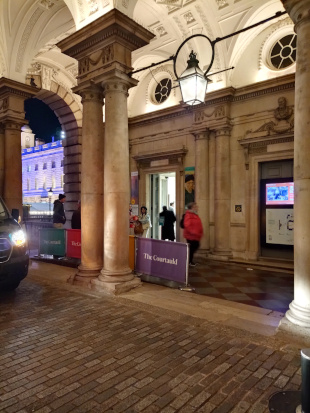

A global archive of independent reviews of everything happening from the beginning of the millennium
Read our Copyright Notice click here
For publication dates click here
The Sir John Soane's Museum, Lincoln's Inn Fields

Part of Robert Adam's Admiralty Screen, Whitehall - an early commission contemporaneous with his work at Hatchlands

Inside the snail, Saw Swee Hock Student Centre, London School of Economics

Inside the new snail, KMSKA, Antwerp
*****
Portico coffering - Royal Exchange building
Christ Church Spitalfields

St Paul's Cathedral
The Pantheon, Paris
Arc de Triomphe du Carrousel

Brussels stock exchange

The Royal Museum of Fine Arts Antwerp - KMSKA
WELCOME to the ARCHITECTURE pages of WORLD REVIEWS!
We have the following reviews in this section :
ARCH0012/1022 click here for:
ROYAL MUSEUM OF FINE ARTS ANTWERP - THE BUILDING
Reviewed by ANDRE BEAUMONT
ARCH0011/1221 click here for:
PEOPLE NOT LAND
Reviewed by ANDRE BEAUMONT
ARCH0010/0419 click here for:
CITY REVISTED
Reviewed by ANDRE BEAUMONT
ARCH0009/1117 click here for:
THE RSA HOUSES
Reviewed by ANDRE BEAUMONT
ARCH0008/0916 click here for:
OSTERLEY PARK
Reviewed by ANDRE BEAUMONT
ARCH0007/0113 click here for:
MANIFESTO
Reviewed by ANDRE BEAUMONT
ARCH0006/1011 click here for:
HIERARCHY AND PROFESSIONALISM
Reviewed by ANDRE BEAUMONT
ARCH0005/PAOLOZZI click here for :
THE COMMISSIONING OF EDUARDO PAOLOZZI
AT TOTTENHAM COURT ROAD UNDERGROUND STATION
Reviewed by ANDRE BEAUMONT
ARCH0004/TRINITY click here for :
TRINITY COLLEGE, CAMBRIDGE'S GREAT COURT
Reviewed by ANDRE BEAUMONT
ARCH0003/NEWMARKET click here for :
NEWMARKET RACECOURSE
Reviewed by ANDRE BEAUMONT
ARCH0002/WOOLNOTH click here for :
ST MARY WOOLNOTH
Reviewed by ANDRE BEAUMONT
ARCH0001/LLOYDS click here for :
LLOYDS BUILDING, LONDON
Reviewed by ANDRE BEAUMONT

Snailcase exiting the Courtauld galleries, Somerset House

The Courtauld, through the fortuitous positioning of its entrance, gets a great porte cochère